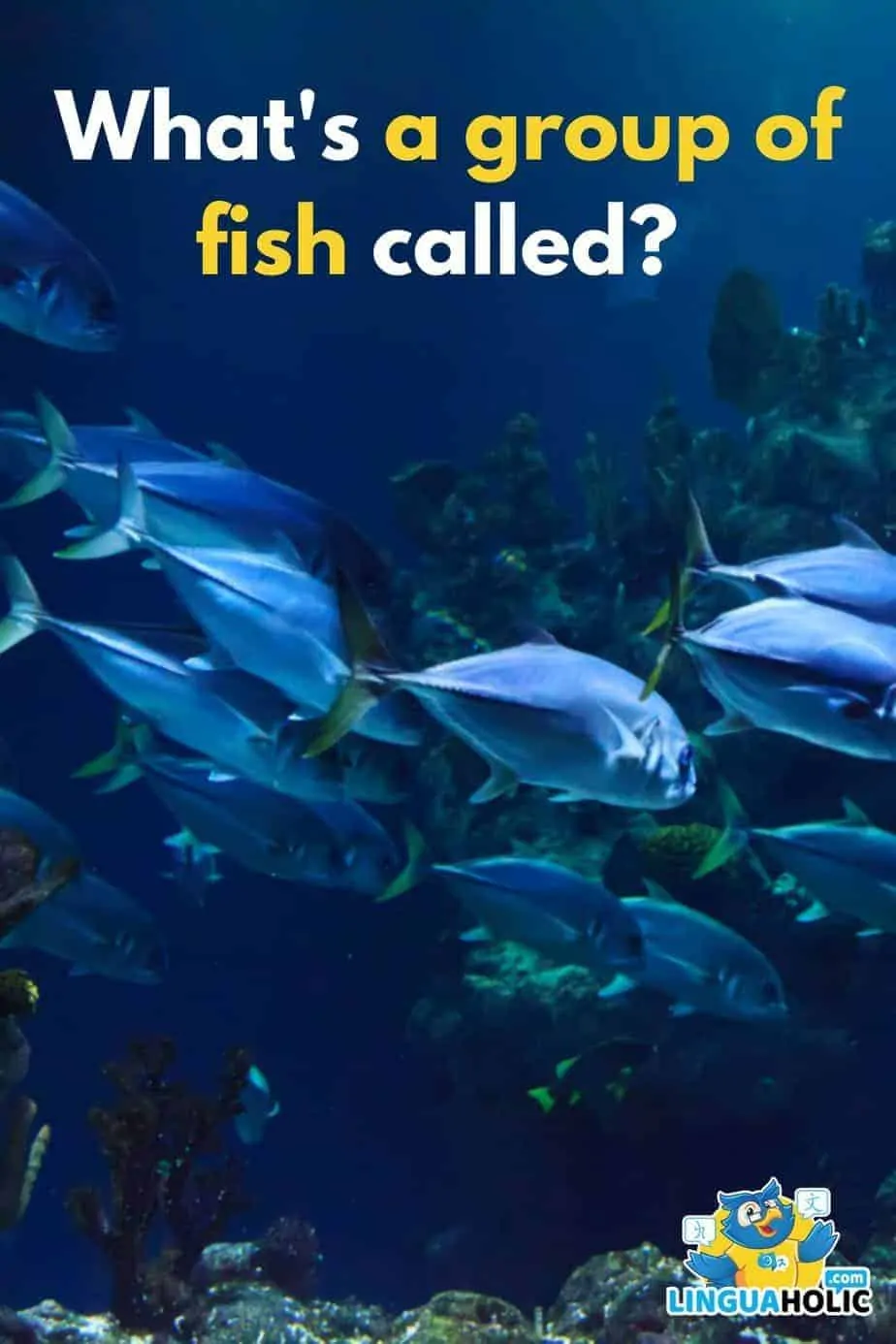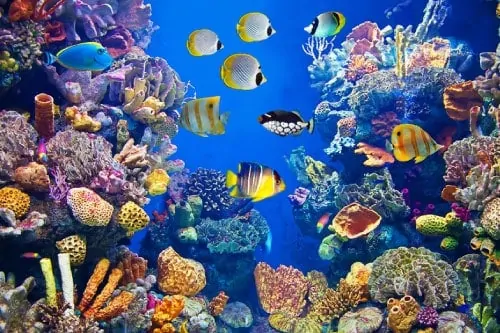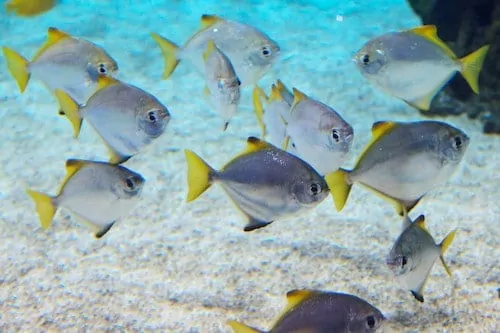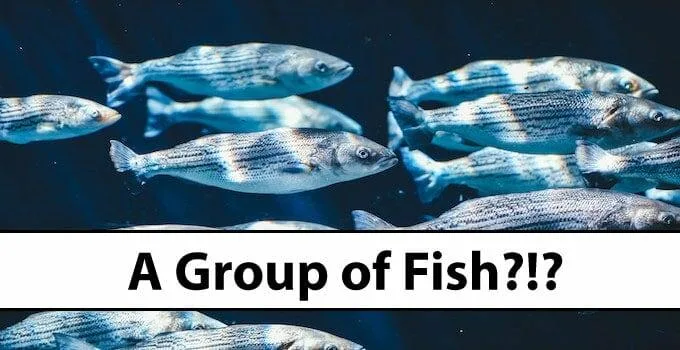Here’s a fun linguistics question for you: What is a group of fish called? The answer to this question might actually surprise you in that there are many different answers to this question!
The right answer to this question actually depends on what the group of fish is doing.
So let us dive right into it!

What is a group of fish called?
A group of fish is either called a shoal of fish (different species) or school of fish (group of only one species). For some fish, however, there are specific phrases to be used such as “a troop of dogfish” and a “glide of flying fish.”
Let us now have a look at these different terms in detail.
The proper way to refer to a group of fish
A collective noun is the name for a collection of things. You could call a group of fish a group of fish, but there is also a more appropriate name, actually, there are a couple of more appropriate terms available if you want to refer to groups of fish in the proper way.
There are many different unique ways to refer to groups of animals. For example, you might refer to a group of seagulls as a flock of seagulls or you might refer to a group of wild horses as a herd of wild horses.
There are two different ways to refer to a group of fish, which are a shoal of fish or a school of fish, depending on some specific facts.
Most fish naturally tend to swim in a group in order to protect themselves from their natural predators. The collective noun that you would use to denote such a group of fish is going to depend on what species of fish you are referring to. Most commonly, the words school and shoal are used to refer to fish that move in a group.
Species-Based Names for a Group of Fish
When dogfish move in a group, however, such a group is referred to as a troop of dogfish.
When eels move in a group they are referred to as a swarm of eels.
Perhaps most interesting is that when flying fish move in a group they are referred to as a glide of flying fish.
Despite the fact that there are specific names for groups of certain species of fish there is nothing wrong with simply calling a group of fish either a shoal of fish or a school of fish depending on the situation.
Define a shoal of fish
Shoal of Fish

A shoal of fish is simply fish grouped together, but it can contain a number of different species all grouped together. Shoaling occurs because it makes it easier for a number of different fish to find food since there are more individuals all on the lookout at the same time.
Working together in larger numbers also makes it possible for fish to find mates. This is also a good way to operate when you are trying to hide from predators, similarly to hiding in a crowd.
Define a school of fish
School of Fish

A school of fish, on the other hand, is made up of fish that are all from the same species. Typically these fish will all swim together and move in a more synchronized manner. It is believed that around 80 per cent of all known species of fish will participate in schools.
There are many different benefits associated with schooling, including improvements in moving through the water because schooling helps to reduce the friction through the many different bodies and the water.
Additionally, because there are so many different bodies all pressed together a large school of fish can often be confusing and even frightening to a predator. Because a school of fish moves in such a precise and cohesive manner, it can take on the appearance of one singular, larger and more formidable creature.
Although there are two different words used for a group of fish, you might be surprised to learn that both of these words have evolved from “schole”, the Dutch root, which means a crowd or a troop.
The Benefits of a Group of Fish
When a group of fish is shoaling, what they are doing is forming a group for a social reason. This could be any of a number of reasons such as searching for food, looking for a new home, protecting themselves from predators, and so on.
Even when the fish are swimming in a somewhat independent manner, they still swim in such a manner that they are behaving in a connected fashion, which makes them a shoal of fish.
It is believed that approximately one-quarter of all fish swim in such a group for their whole lives, and approximately half of all fish swim in a group for at least part of their lives.
When fish swim in groups, it is far less likely that any one of them is going to be eaten by a predator. Swimming in a group will also dramatically increase the opportunities for a fish to find food as well as a mate. In other words, there are many benefits associated with fish swimming in these social groups. Fish may also be able to swim faster and more effectively when swimming in a group rather than by itself.
Fish generally seem to prefer larger groups rather than smaller groups and generally seem to prefer group mates of their own species rather than grouping with fish that come from other species.
Science has also demonstrated that fish will prefer group mates that are relatively similar in size and appearance to themselves, and tend to choose healthier group mates and their own kin when they recognize them.
This is likely because a group mate that stands out from the crowd is more likely to be targeted by a predator and eaten, and so there is something to be said for blending in with the crowd in a group of fish.
Some fish spend literally all of their time schooling, including certain species such as anchovy, herring, and tuna. These species can actually become quite agitated if they are separated from their school because they are so accustomed to being a part of their group of fish. Other species such as the Atlantic cod only school for a portion of their lives.
What will you call a group of fish?
When you are referring to a group of fish, you can always decide to refer to the specific species as there are some species-specific collective nouns available or you can choose to refer to the group based on the specific social activity the group is engaging in.
If you happen to spy a group of fish that is swimming sort of casually while looking for food and you happen to notice that there are a couple of different species making up the group then you will probably best benefit from calling the group a shoal of fish.
If on the other hand, you happen to spy a group of fish that is quickly swimming in a tight formation and the entire group consists of a singular species of uniform fish then you should refer to the group as a school of fish.
Although it does not really make an enormous difference if you refer to a shoal as a school or a school as a shoal, there are definitely some details between one and the other, even just in terms of the species that are grouping and the purposes for which the species might be grouping.
Other Collective Nouns for Animal Groups
Many different types of animal groups have specific collective noun names that you can use to refer to them. For example, if you want to refer to a group of lions you can refer to them as a pride or as a coalition depending on if you a referring to a group of female lions or male lions respectively. A group of cattle is referred to as a herd of cattle, regardless of whether you are referring to cows or bulls.
Sometimes you can use a few different words to refer to the same type of animal, such as a group of birds.
When referring to a group of hens, you would call them a brood, but a group of penguins is called a colony.
You would call a group of geese a gaggle but a group of quail is a bevy. If on the other hand, you are interested in referring to a group of birds in general then you should know that a group of birds is called a flock of birds.
Another example is that there are several different collective nouns to refer to ants including swarm, army, column and state. So you could refer to a group of ants as an army, or a swarm of ants, or a state of ants if you wanted.
Bees are another species that have several different collective nouns that you might use to describe them. You can use cluster, swarm, drift, hive, or erst to describe a group of bees. Although swarm of bees or hive of bees are the most common collective nouns used to describe groups of bees, there are plenty of other terms that can be used as well. There are also other animal species that only have a singular collective noun used to describe their groupings. For example, a group of baboons is called a troop, a group of bears is called a sloth, and a group of apes is called a shrewdness.

Hey fellow Linguaholics! It’s me, Marcel. I am the proud owner of linguaholic.com. Languages have always been my passion and I have studied Linguistics, Computational Linguistics and Sinology at the University of Zurich. It is my utmost pleasure to share with all of you guys what I know about languages and linguistics in general.

